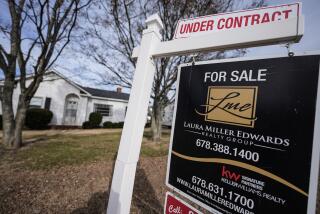Young Buyers Have Ally
- Share via
In this age of aggressive marketing and hype--to sell anything and everything--is there anyone out there who represents, or lobbies for, the first-time home buyer?
The answer could be a home builder, of all people.
Those in the home construction business, oddly enough, represent a strong conduit for young would-be buyers, who otherwise virtually stand alone in the real world of advocacy and lobbying.
Politicians aside, their only public and visible advocate appears to be the home builder. Of course, builders have their own self-serving song to sing. They are in the business of home construction and sales.
But when their product is priced out of the range of a vast potential market of young people and new families, as it is now in so many cases because of a variety of fees levied on housing, it hurts, and they want relief.
A respected spokesman for the industry, DeVere H. Anderson, president of the Building Industry Assn. of Southern California, points out that infrastructure fees alone--charged to builders--increased by an astounding 558.8% per housing unit between 1975 and 1983 in selected Southland jurisdictions.
That meant that a new California home in 1975 bore an added-on fee of $1,009, while the new 1983 home contained a $6,647 added-on fee. The builder simply “passed along” his firm’s contribution to the area’s or the tract’s infrastructure to the new buyer.
Before Proposition 13, he explained, there were park, sewer, water and drainage fees that the builder had to pay.
After passage of tax-limiting Proposition 13 in 1978, a dozen more were added--fees for traffic mitigation, development, schools, watershed, public arts, sewer capital improvement, water capital improvement, construction tax, property development tax, traffic circulation, underground utilities and bedroom tax.
Developers and builders became the big, visible target for the needed funds, denied by the enactment of the trend-setting Jarvis-Gann measure.
By the BIA’s calculation, the effective average increase in home prices, accounting for fees for infrastructure, planning, building and engineering, rose by 218.7% between 1975 and 1983.
As a result of all these add-on fees, plus inflation, the median sales price of a new California home escalated to $138,000 in 1986--at least $46,000 more than its national counterpart, according to the Construction Industry Research Board.
The current no-growth movement, Anderson said, is an easy out for government officials and agencies, but it stymies the construction industry’s efforts to provide affordable housing. Initiative measures become a double-edged sword, he added, because they don’t solve housing needs.
How does the BIA intend to combat further encroachment into its turf and, consequently, lessen the affordability gap for the typical young couple?
The hard answer seems to be by lobbying, legislation and supporting only candidates for public office who understand the problem and the dilemma, not only of the would-be buyer, but of the buyer’s “unlikely” ally, the builder.
Along with builders wanting to stay in business for profit, they do want to serve their customers, particularly the new ones, by providing them with that endangered and nearly extinct property, the affordable house.
How do they emphasize to the would-be buyer what the real cost of the house is? Put an invoice sticker on the front door, just like the stickers auto dealers put on car windows?
That might pinpoint costs, but the add-on fees ranging upward of $3,000 to $5,000 per house don’t provide the buyer with any more house, not a den, another bedroom or a hot tub.
More to Read
Inside the business of entertainment
The Wide Shot brings you news, analysis and insights on everything from streaming wars to production — and what it all means for the future.
You may occasionally receive promotional content from the Los Angeles Times.










